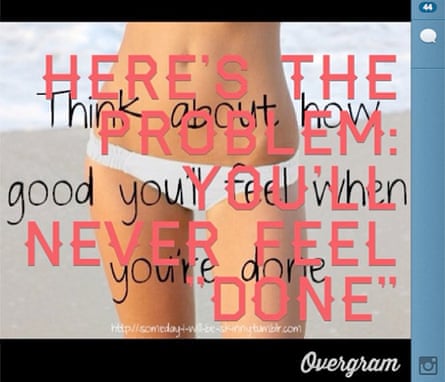Do a quick search on Instagram and you will find reams of "thinspiration" material, usually in the form of pictures that glamorises the extreme skinniness of various models and celebrities.
Hashtags such as #thynspo, #ana (for anorexia), #mia (for bulimia) and #blithe (code for self-harm) abound. From there you can find thousands of pictures of bloody wrists and thighs, messages of despair and cries for help, and photos of underweight women that mostly focus on apparent ribs, concave stomachs, thigh gaps, and prominent hip and collar bones.
Perhaps most distressing are the pro-anorexic quotes interspersed between pictures, such as "Do it for the thigh gap", "Skip dinner, weigh up thinner," "1 like = 10 squats," "Do not reward yourself with food, you're not a dog" and the most frequently posted shibboleth, Kate Moss's infamous quote: "Nothing tastes as good as skinny feels."
Community support for these self-destructive illnesses is not unlike the first wave of pro-ana virtual communities of the late 1990s, though the nature of an image-based social networking service means that random friendships occur more easily thanks to hashtags, and an emphasis on imagery that dangerously ratifies the erroneous assumption that only skinny women are beautiful. There, thinstagrammers photo-blog their daily frustrations and struggles, and comment on each other's pictures to encourage fasting. Recovery accounts sometimes pop up too, usually gently advising people to get help.

When I first scrolled through those pictures, my kneejerk reaction was disgust. The idea that Instagram users are tagging photos that promote the obsession with thinness as a lifestyle, rather than a mental illness, infuriated me. I've never had an eating disorder, but I know that while illnesses such as anorexia nervosa are widely accepted as containing a genetic component, many studies have also indicated the impact of sociocultural factors (peer pressure, troubled relationships, sexual abuse and the ideal beauty type prevailing in western culture) that trigger people into becoming eating-disordered.
Instagram's policing measures have been thus far unsuccessful. The company added a pop-up disclaimer for #ana and #mia with a link to the American National Eating Disorders website and in April 2012 the company publicly banned #thin, #thinspiration and #thinspo, which prompted Thinstagrammers to spell new hashtags differently – for example #thynspo or #thinspoooo. As such, Instagram's policies might come off as more a perfunctory PR gesture (and a cover-your-ass move) than a committed strategy to police graphic content, though admittedly the problem feels like an unstoppable plague.
I wanted to try something different. Upon finding a number of pro-recovery Instagram accounts tagged with words such as #edrecovery, I decided to make one myself (@lovethighself) in order to use pro-ana hashtags in an attempt to subvert and effectively spam pro-ana communities. I posted hundreds of quotes that promoted recovery and body acceptance, as well as attractive pictures of average and plus-sized models. I also photoshopped some of the common pro-ana images to refute their harmful messaging.

These attempts were not intended to be dismissive of a mental illness I do not have, nor to raise the ire of people with anorexia or bulimia, but rather to enable users looking up these hashtags to reconsider their scrolling habits. I figured that not everyone looking at thinspiration has an eating disorder. Some who do may be on the verge of relapse from recovery, while others who don't (yet) might be slowly becoming obsessed with their weight and curious about thinspiration and dieting tips, putting themselves at risk.
"Thinspo" has overwhelmingly been proven to cause negative effects even in the non-eating-disordered. One study published by the European Eating Disorders Review found that college women without a history of eating disorders who looked at pro-ana websites reduced their calorie intake in the following weeks, half of them unconscious they were doing so. By posting a reactionary wave of images promoting body acceptance while negating the beliefs of ana advocates, I hoped to make a difference.
I soon received tons of comments thanking me and urging me to keep posting. "Please always keep this account. I'm going through an eating disorder and I'm fighting so hard but it pulls me down a lot and I just am still trying to overcome it. My screen saver is one of your pictures and it helps me so much," wrote one follower. Many users who self-identified as having ana or mia in their bios began to follow me, and I started following some of them, too, providing support when I could. But sadly, because of the sheer mass of thinspiration pictures posted on Instagram every day, it's been impossible for me to truly dent the thinstagram subculture.
The degree to which western society's ideal body type has diminished our sense of self-worth is unmeasurable, but unmistakably and dangerously high. Young girls are crying out for help, using Instagram as an emotional outlet and banding together around a service to commiserate. It's understandable that such communities form, given the isolating effects of eating disorders. But while they can be somewhat helpful in allowing the eating-disordered to have a voice, #ana and #mia are also likely to further fuel their disorders.
As it is, thinspiration is an unstoppable movement. Until our society stops telling young girls they can only be accepted if they are thin, pro-ana users will likely always find a place to unify on the web.
